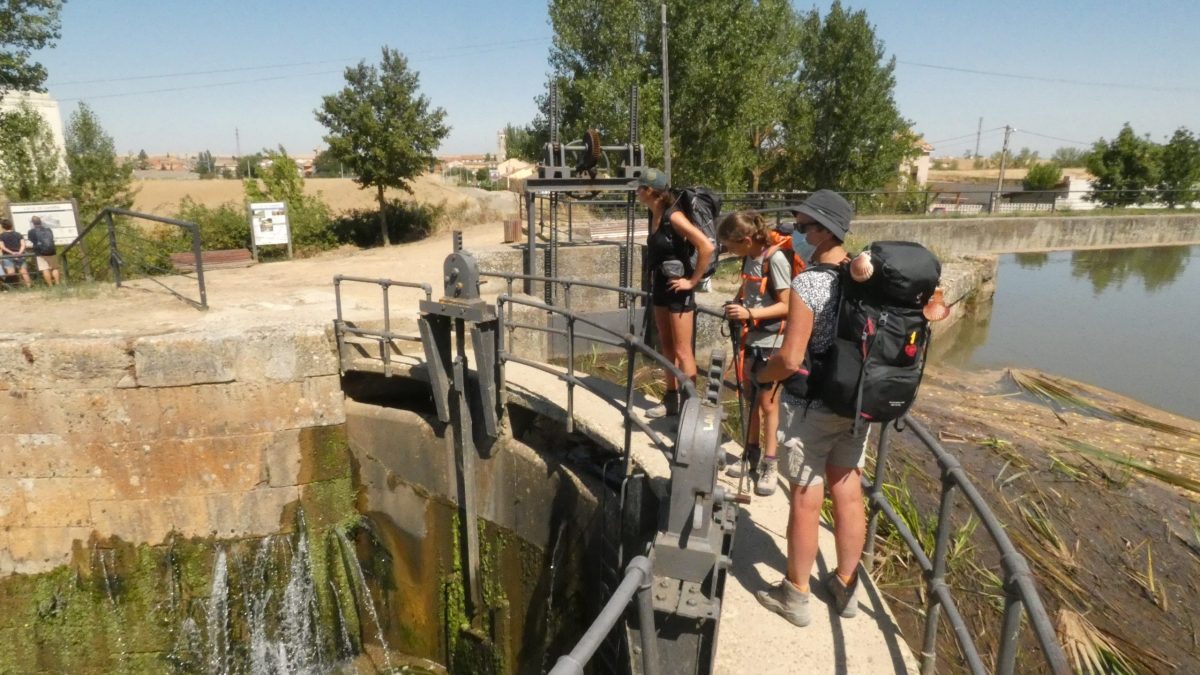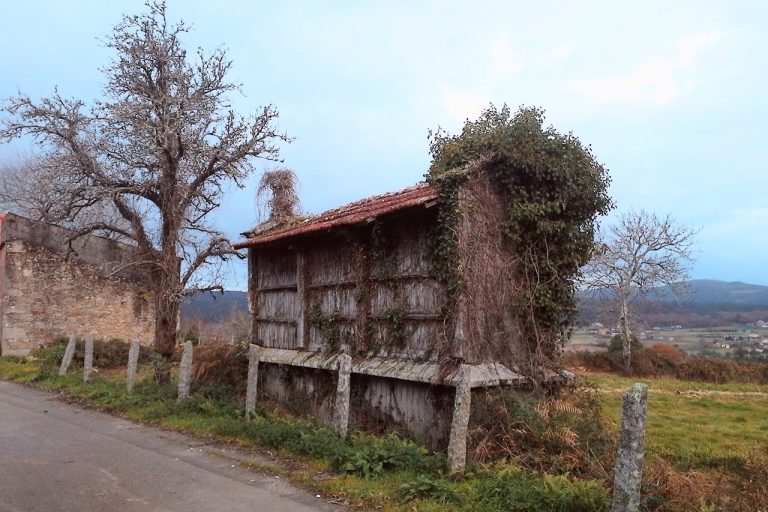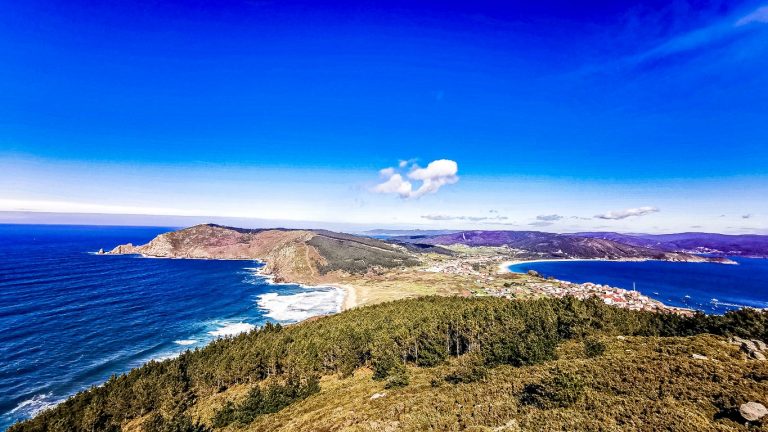
A New Stage Day – Introduction & Mood
Castrojeriz still rests in the dawn as you shoulder your bundle and walk down the narrow street through the town. Behind you lie the ruins of the castle, throning like a stone guardian above the village. Before you, a new day unfolds – a day that will test your strength right from the start.
The first steps out of Castrojeriz lead you through the fields in the gentle light. But after only a short while, the Alto de Mostelares rises before you, a steep wall of gravel that shines in the morning sun like a touchstone. Here, right at the beginning, the Camino separates the easy from the serious: you will pant, sweat, maybe curse – but up top awaits vastness, clear and endless.
It is a day that begins with exertion but then releases you into a peace that only the Meseta can offer.
Route & Elevation Profile
- Distance: approx. 25 km
- Elevation gain/loss: +200 m / –200 m
- Difficulty: medium – demanding due to the steep climb at the Alto de Mostelares right after Castrojeriz, afterwards relaxed and flat.
The stage divides into two faces: first the ascent and descent at the Alto, intense and powerful, then the long, silent straights of the Meseta. At the end, the Canal de Castilla awaits, whose waters and riverside trees bring a welcome change to the plain.













Variants & Small Detours
The main route is clear and straightforward: Alto de Mostelares – Itero del Castillo – Boadilla del Camino – Frómista.
A small variant leads at Itero de la Vega across the medieval Puente Fitero over the river Pisuerga. It marks the border between Castile and León and has always been an important crossing for pilgrims.
Description of the Way – With All Senses
The town still lies behind you as the path rises gently and then more steeply. The Alto de Mostelares rises abruptly, and the next 1.5 kilometers demand every muscle. The gravel crunches, your breath grows heavy, yet step by step you climb the height. At the top, at about 900 meters, a view over the Meseta opens up to you, so wide and free that the strenuous ascent seems to vanish.
The descent follows immediately: steep, slippery, and yet a gift, because it brings you back to the plain. Here the landscape widens, and the Camino leads you like on a quiet ribbon through fields shimmering in the sun.
After a few kilometers you reach Itero del Castillo, a tiny village with a Romanesque church. Not far away lies the Puente Fitero, a medieval bridge over the Pisuerga, connecting Castile with Palencia. When you cross it, you know you are entering a new province – a symbolic step, another piece of progress westward.
The way continues to Boadilla del Camino, a small but impressive village. On the square in front of the church stands a magnificent Rolla, a stone pillory column that tells of the importance of the village in the Middle Ages. Here it is worth pausing for a moment, filling your water, and contemplating the beauty of the simple houses.
From Boadilla the Camino leads onto a special section: the Canal de Castilla. A ruler-straight waterway, flanked by poplars, once intended as a trade route and today offering pilgrims shade and an almost meditative calm. The murmuring of the water, the rustling of the leaves – a contrast to the vast fields, a whisper that accompanies you all the way to Frómista.
Frómista welcomes you with its famous Romanesque church of San Martín de Tours, a masterpiece of simple harmony. After the expanse and severity of the Meseta, this building appears like a place of rest: round, clear, complete.
Intermediate Villages & Special Features
| Place | Distance from Castrojeriz | Special feature |
| Alto de Mostelares | approx. 2 km | Steep ascent with magnificent view |
| Itero del Castillo | approx. 10 km | Small village with Romanesque church |
| Puente Fitero | approx. 11 km | Medieval bridge over the Pisuerga, border between Castile & León |
| Boadilla del Camino | approx. 19 km | Pillory column (Rolla), village square, supplies |
| Frómista | 25 km | Romanesque church of San Martín de Tours |
Packing & Shopping Tips
- Water & snacks: After the climb to the Alto there are long stretches without supplies. Refill at the latest in Itero del Castillo.
- Sun protection: The section between Itero and Boadilla is open and without shade – hat and sunscreen are essential.
- Shoes: The descent from the Alto is steep and slippery – good footwear and attention are crucial here.
Food, Accommodation & Supplies
Frómista is a pilgrim town with good infrastructure: albergues, guesthouses, restaurants, and shops. The Romanesque church of San Martín is a jewel and should definitely be visited – it counts among the most important monuments on the entire Camino Francés.
There are also some albergues in Boadilla, some with garden and swimming pool – a gift on hot days.
Today’s Special Features
The Alto de Mostelares is the defining experience of this stage: a short but powerful climb, followed by a descent that releases you into vastness. Many pilgrims consider this hill a symbol of the Camino – a touchstone that demands strength but grants a great reward.
Equally impressive is the section along the Canal de Castilla. This artificial waterway from the 18th century was once intended for the transport of grain. Today it is a place of silence, where you can walk in the rhythm of water and trees – almost like in a green cathedral.
And finally Frómista: the church of San Martín de Tours, with its clear forms, capitals, and arches, guiding pilgrims for centuries. A building that shows how strongly spirituality and art can merge.
Reflection at the End of the Stage
The day began with a climb that tested your muscles and ended with a church that calmed your heart. Perhaps in the evening in Frómista you will think: “The Camino tests us not only in exertion but also grants us moments of complete peace.”
📊 Tabular Overview
| Stage | Start | Goal | Distance | Elevation gain/loss | Difficulty | Intermediate places |
| 15 | Castrojeriz | Frómista | approx. 25 km | +200 / –200 m | medium | Alto de Mostelares, Itero del Castillo, Puente Fitero, Boadilla del Camino |
🌌 Camino of the Stars – Stage 15
Castrojeriz → Alto de Mostelares → Itero del Castillo → Puente Fitero → Boadilla del Camino → Frómista
Did you enjoy this stage, or do you have special memories of the Alto de Mostelares or the Canal de Castilla? Share your thoughts – your story makes the Camino even more alive.


